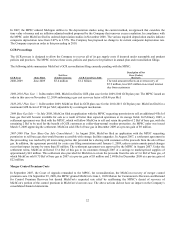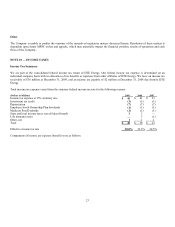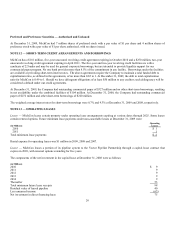DTE Energy 2009 Annual Report Download - page 19
Download and view the complete annual report
Please find page 19 of the 2009 DTE Energy annual report below. You can navigate through the pages in the report by either clicking on the pages listed below, or by using the keyword search tool below to find specific information within the annual report.17
NOTE 5 — FINANCIAL AND OTHER DERIVATIVE INSTRUMENTS
The Company recognizes all derivatives on the Consolidated Statements of Financial Position at their fair value unless they qualify for
certain scope exceptions, including the normal purchases and normal sales exception. Further, derivatives that qualify and are
designated for hedge accounting are classified as either hedges of a forecasted transaction or the variability of cash flows to be
received or paid related to a recognized asset or liability (cash flow hedge), or as hedges of the fair value of a recognized asset or
liability or of an unrecognized firm commitment (fair value hedge). For cash flow hedges, the portion of the derivative gain or loss
that is effective in offsetting the change in the value of the underlying exposure is deferred in Accumulated other comprehensive
income and later reclassified into earnings when the underlying transaction occurs. For fair value hedges, changes in fair values for
both the derivative and the underlying hedged exposure are recognized in earnings each period. Gains and losses from the ineffective
portion of any hedge are recognized in earnings immediately. For derivatives that do not qualify or are not designated for hedge
accounting, changes in the fair value are recognized in earnings each period. Gains and losses from the ineffective portion of any
hedge are recognized in earnings immediately.
The Company’ s primary market risk exposure is associated with commodity prices, credit and interest rates. MichCon has risk
management policies to monitor and manage market risks.
Commodity Price Risk
The Company has fixed-priced contracts for portions of its expected gas supply requirements through 2013. These gas supply
contracts are designated and qualify for the normal purchases and sales exemption and are therefore accounted for under the accrual
method. We may also sell forward storage and transportation capacity contracts. Forward firm transportation and storage contracts are
not derivatives and are therefore accounted for under the accrual method.
Credit Risk
The Company is exposed to credit risk if customers or counterparties do not comply with their contractual obligations. MichCon
maintains credit policies that significantly minimize overall credit risk. These policies include an evaluation of potential customers’
and counterparties’ financial condition, credit rating, collateral requirements or other credit enhancements such as letters of credit or
guarantees. The Company generally uses standardized agreements that allow the netting of positive and negative transactions
associated with a single counterparty.
The Company maintains a provision for credit losses based on factors surrounding the credit risk of its customers, historical trends,
and other information. Based on the Company’ s credit policies and its December 31, 2009 provision for credit losses, the Company’ s
exposure to counterparty nonperformance is not expected to result in material effects on the Company’ s financial statements.
Interest Rate Risk
MichCon occasionally uses treasury locks and other interest rate derivatives to hedge the risk associated with interest rate market
volatility. In 2004, MichCon entered into an interest rate derivative to limit its sensitivity to market interest rate risk associated with
the issuance of long-term debt. Such instrument was designated as a cash flow hedge. The Company subsequently issued long-term
debt and terminated the hedge at a cost that is included in accumulated other comprehensive loss. Amounts recorded in other
comprehensive loss will be reclassified to interest expense as the related interest affects earnings through 2033.
























